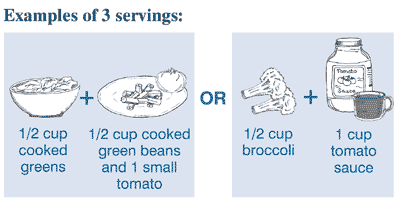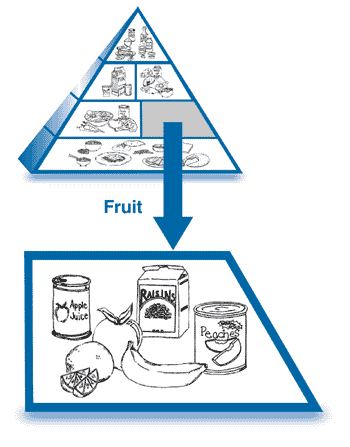What are healthy ways to eat vegetables?
FruitFruit gives you energy, vitamins, minerals, and fiber.
|
|||||||||||||||||||||||||||||||||||||||||||||||||||||||||||||||||||||||||||||||||||||||||||||||||||||||||||||||||||||||||||||||||||||||||||||||||||||||||||||||||||||||||||||||||||||
|
1. How many
servings of fruit do you now eat each day? I eat _____ fruit servings each day. 2. Check how many servings of fruit to have each day in the
section on
How much should I eat each day. To control your blood glucose, spread the servings you eat throughout the day. 3. I will eat this many servings of fruit at
A diabetes teacher can help you with your meal plan. |
What are healthy ways to eat fruit?
- Eat fruits raw or cooked, as juice with no sugar added, canned in their own juice, or dried.
- Buy smaller pieces of fruit.
- Eat pieces of fruit rather than drinking fruit juice. Pieces of fruit are more filling.
- Drink fruit juice in small amounts.
- Save high-sugar and high-fat fruit desserts such as peach cobbler or cherry pie for special occasions.
Milk and Yogurt
Milk and yogurt give you energy, protein, fat, calcium, vitamin A, and other vitamins and minerals.

How much is a serving of milk and yogurt?

Note: If you are pregnant or breastfeeding, have four to five servings of milk and yogurt each day.
Print out this chart. Then fill in the blanks with how many servings of milk and yogurt to have at meals and snacks.
|
1. How many
servings of milk and yogurt do you now have each day? I have _____ milk and yogurt servings each day. 2. Check how many servings of milk and yogurt to have each day in
the section on
How much should I eat each day. To control your blood glucose, spread the servings you have throughout the day. 3. I will have this many servings of milk and yogurt at
A diabetes teacher can help you with your meal plan. |
What are healthy ways to have milk and yogurt?
- Drink fat-free (skim or nonfat) or low-fat (1%) milk.
- Eat low-fat or fat-free fruit yogurt sweetened with a low-calorie sweetener.
- Use low-fat plain yogurt as a substitute for sour cream.
Meat and Meat Substitutes
The meat and meat substitutes group includes meat, poultry, eggs, cheese, fish, and tofu. Eat small amounts of some of these foods each day.
Meat and meat substitutes help your body build tissue and muscles. They also give your body energy and vitamins and minerals.

Examples of meat and meat substitutes include
|
|
|
How much is a serving of meat or meat substitute?

*Two to three ounces of meat (after cooking) is about the size of a deck of cards.
Print out this chart. Then fill in the blanks with how many servings of meat and meat substitutes to have at meals and snacks.
|
1. How many servings of meat or meat substitutes
do you now eat each day? 2. Check how many servings of meat or meat
substitutes to have each day in the section on
How much should I eat each day. To control your blood glucose, spread the servings you eat throughout the day. 3. I will eat this many servings of meat or meat substitutes at
A diabetes teacher can help you with your meal plan. |
What are healthy ways to eat meat or meat substitutes?
-
Buy cuts of beef, pork, ham, and lamb that have only a little fat on them. Trim off extra fat.
-
Eat chicken or turkey without the skin.
-
Cook meat or meat substitutes in low-fat ways:
-
broil
-
grill
-
stir-fry
-
roast
-
steam
-
stew
-
-
To add more flavor, use vinegars, lemon juice, soy or teriyaki sauce, salsa, ketchup, barbecue sauce, and herbs and spices.
-
Cook eggs with a small amount of fat or use cooking spray.
-
Limit the amounts of nuts, peanut butter, and fried chicken that you eat. They are high in fat.
-
Choose low-fat or fat-free cheese.
Fats and Sweets
Limit the amounts of fats and sweets you eat. They have calories, but not much nutrition. Some contain saturated fats and cholesterol that increase your risk of heart disease. Limiting these foods will help you lose weight and keep your blood glucose and blood fats under control.

Examples of fats include
|
|
|
Examples of sweets include
|
|
|
How much is a serving of sweets?

How much is a serving of fat?


How can I satisfy my sweet tooth?
It's okay to have sweets once in a while. Try having sugar-free popsicles, diet soda, fat-free ice cream or frozen yogurt, or sugar-free hot cocoa mix.
Other tips:
-
Share desserts in restaurants.
-
Order small or child-size servings of ice cream or frozen yogurt.
-
Divide homemade desserts into small servings and wrap each individually. Freeze extra servings.
-
Don't keep dishes of candy in the house or at work.
Remember, fat-free and low-sugar foods still have calories. Talk with your diabetes teacher about how to fit sweets into your meal plan.
Alcohol
Alcohol has calories but no nutrients. If you drink alcohol on an empty stomach, it can make your blood glucose level too low. Alcohol also can raise your blood fats. If you want to drink alcohol, talk with your doctor or diabetes teacher about how it fits into your meal plan.
Print out this chart to plan your meals and snacks for one day. (Work with your diabetes teacher if you need help.)
|
Breakfast |
||
|
Food Group |
Food |
How Much |
|
|
|
|
|
|
|
|
|
|
|
|
|
Snack |
||
|
Food Group |
Food |
How Much |
|
|
|
|
|
|
|
|
|
Lunch |
||
|
Food Group |
Food |
How Much |
|
|
|
|
|
|
|
|
|
|
|
|
|
Snack |
||
|
Food Group |
Food |
How Much |
|
|
|
|
|
|
|
|
|
Dinner |
||
|
Food Group |
Food |
How Much |
|
|
|
|
|
|
|
|
|
|
|
|
|
Snack |
||
|
Food Group |
Food |
How Much |
|
|
|
|
|
|
|
|
TOP
Measuring Your Food
To make sure your food servings are the right size, use
-
measuring cups
-
measuring spoons
-
a food scale
Also, the Nutrition Facts label on food packages tells you how much of that food is in one serving.
Weigh or measure foods to make sure you eat the right amounts.
These tips will help you choose the right serving sizes.
-
Measure a serving size of dry cereal or hot cereal, pasta, or rice and pour it into a bowl or plate. The next time you eat that food, use the same bowl or plate and fill it to the same level.
-
For one serving of milk, measure 1 cup and pour it into a glass. See how high it fills the glass. Always drink milk out of that size glass.
-
Meat weighs more before it's cooked. For example, 4 ounces of raw meat will weigh about 3 ounces after cooking. For meat with a bone, like a pork chop or chicken leg, cook 5 ounces raw to get 3 ounces cooked.
-
One serving of meat or meat substitute is about the size and thickness of the palm of your hand or a deck of cards.
-
A small fist is equal to about 1/2 cup of fruit, vegetables, or starches like rice.
-
A small fist is equal to 1 small piece of fresh fruit.
-
A thumb is equal to about 1 ounce of meat or cheese.
-
The tip of a thumb is equal to about 1 teaspoon.
When You Are Sick
It's important to take care of your diabetes even when you're ill. Here are some tips on what to do:
-
Even if you can't keep food down, keep taking your diabetes medicine.
-
Drink at least one cup (8 ounces) of water or other calorie-free, caffeine-free liquid every hour while you're awake.
-
If you can't eat your usual food, try drinking juice or eating crackers, popsicles, or soup.
-
If you can't eat at all, drink clear liquids such as ginger ale. Eat or drink something with sugar in it if you have trouble keeping food down, because you still need calories. If you don't have enough calories, you increase your risk of hypoglycemia (low blood sugar).
-
Make sure that you check your blood glucose. Your blood glucose level may be high even if you're not eating.
-
Call your doctor right away if you throw up more than once or have diarrhea for more than 6 hours.
Points to Remember
-
What, when, and how much you eat all affect your blood glucose level.
-
You can keep your blood glucose at a healthy level if you
-
Eat about the same amount of food each day.
-
Eat at about the same times each day.
-
Take your medicines at the same times each day.
-
Exercise at the same times each day.
-
-
Every day, choose foods from these food groups: starches, vegetables, fruit, meat and meat substitutes, and milk and yogurt. How much of each depends on how many calories you need a day.
-
Limit the amounts of fats and sweets you eat each day.
California Diabetes Foundation
2975 Huntington Drive, Suite 202
San Marino, CA 91108
USA
Email:
info@diabetesfoundation.org
| Disclaimer | TOP |
*NDEP is a Joint Program of the National Institutes of Health and the Centers for Disease Control and Prevention
| Home | | Diabetes Diet | | Get Tested | | Diabetes Recipe | | Diabetes Record | | Diabetes Control |















